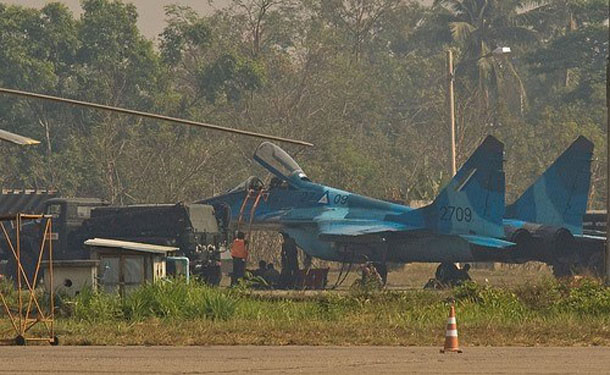Fighting that first erupted between an ethnic Kokang armed rebel group and government troops on Monday morning continued in the northern Shan State town of Laukkai on Tuesday.
Reports in state-run media blamed the Kokang, an ethnic minority primarily settled in the area between the Salween River and China border, for the clashes in Laukkai and an ambush on a Burma Army outpost in Mawhtike town. Those reports said the fighting had caused public alarm in the area, which is part of a self-administered zone granted to the Kokang in the Constitution.
“While the State is making all-out efforts for reaching a nationwide ceasefire, the renegade groups of Kokang have ambushed the troops of the Tatmadaw [Burma Army],” reported The Global New Light of Myanmar.
Htun Myat Lin, a spokesperson for the ethnic Kokang Myanmar National Democratic Alliance Army (MNDAA), said at least four rebel soldiers were injured in Monday’s clashes but he denied Kokang involvement in any ambush, saying instead that Burma Army troops had fired the first shots.
“We have also been attacked by air strikes—three times at around 3:30 pm yesterday and two times an hour ago today,” he said on Tuesday, adding that three Burma Army troops were killed in Monday’s fighting.
Tensions have been rising in the areas since clashes broke out in the town of Kunlong in December. The latest violence is believed to be a struggle for territory in the volatile region.
“We were forced to leave our homeland in 2009 and now we are back for our lands,” Htun Myat Lin told The Irrawaddy.
A local resident of the nearby town of Hopan told The Irrawaddy that gunfire was heard last night until 2:00 am, while an allied ethnic group confirmed that the clashes continued on Tuesday morning.
Speaking on condition of anonymity, the local resident said: “The gunfire from Chin Shwe Haw [Township] was heard from 7:30 pm to 2:00 am last night. Travel to Chin Shwe Haw, some three miles away from Hopan, and also the route to Laukkai, is now blocked and I heard people in the area are fleeing for Mandalay and the China border.”
Mai Aik Kyaw, a communications officer for the Ta’ang National Liberation Army (TNLA), told The Irrawaddy on Tuesday that fighting first flared on Monday morning, pitting TNLA and allied Kokang troops against the government’s Light Infantry Battalion No. 125, with hostilities ongoing.
The TNLA has allied with the MNDAA, according to Mai Aik Kyaw, in an effort to retake the self-administered zone, which the MNDAA controlled until 2009. A post on the TNLA headquarters’ Facebook page said fighters of the Arakan Army had joined the TNLA and MNDAA.
State media reported that clashes broke out at least three times on Monday in Nyankhwan and Taukshwe villages, located northwest and southwest of Laukkai, respectively.
More government troops have been deployed to Laukkai, according to both local residents and the TNLA.
“The Tatmadaw reinforced with many more troops yesterday and I heard battalions under Military Operations Command No. 16 are on their way,” said Mai Aik Kyaw, while also echoing the MNDAA spokesman’s claim that a fighter jet was involved in the government’s offensive.
A video obtained by The Irrawaddy purportedly shows an airstrike being carried out by a Burma Army helicopter gunship in the region in recent days.
The TNLA, which has not signed a bilateral ceasefire with the government, has been involved in frequent clashes with government troops in northern Shan State including separate fighting in Namatu Township over the last 10 days.
The MNDAA also lacks a ceasefire with the government, and has entered into alliances with several other ethnic armed groups in the area, including the TNLA and the Kachin Independence Army, both of which remain openly at war with the Burma Army.
The Kokang rebel group is a member of both the United Nationalities Federal Council (UNFC), and the Nationwide Ceasefire Coordinating Team (NCCT), but the government has balked at the group’s efforts to win a seat at the negotiating table in peace talks aimed at achieving a nationwide ceasefire.

















